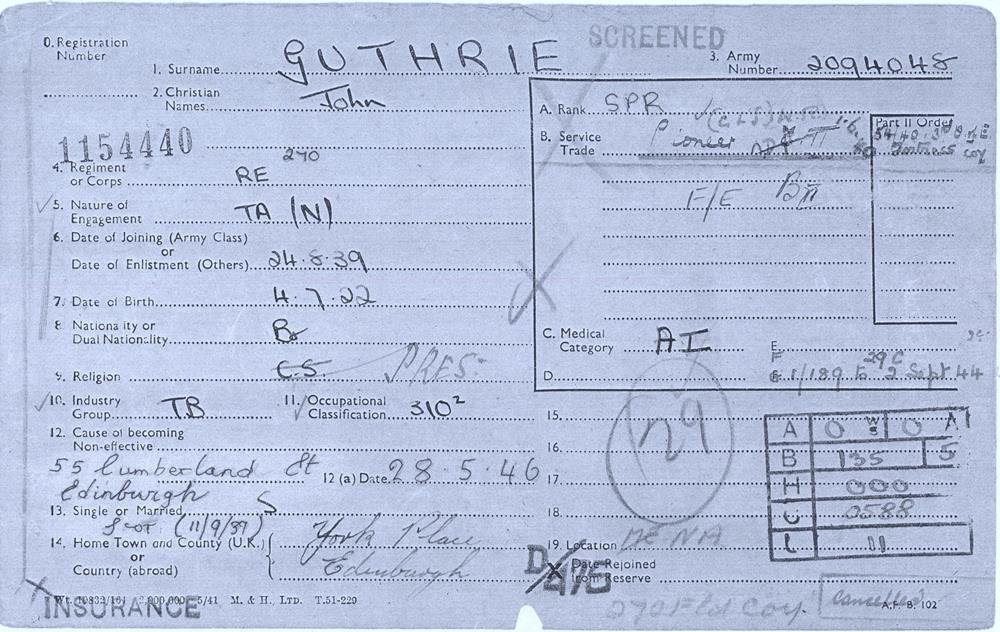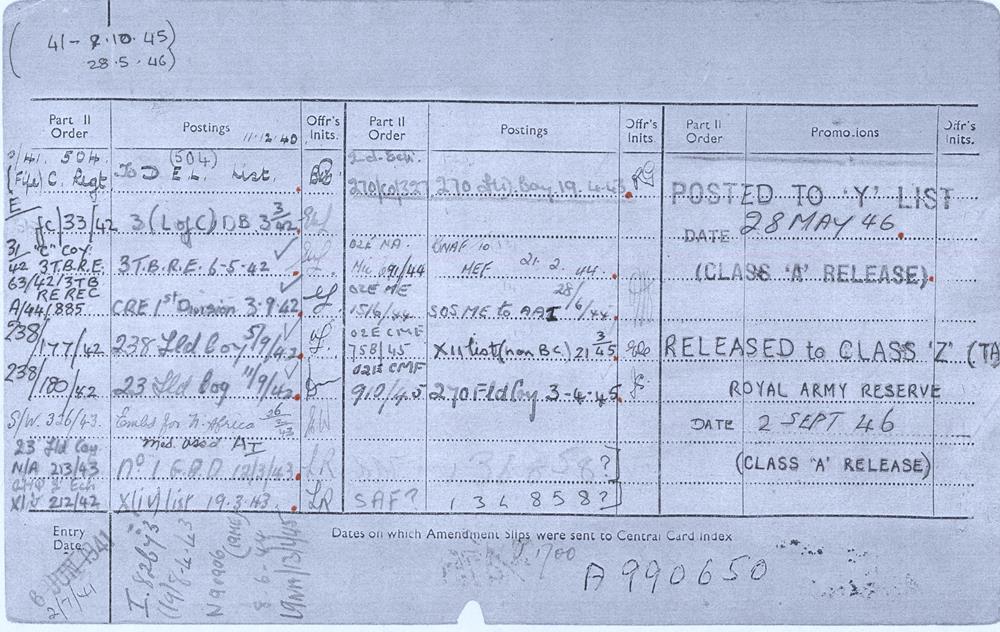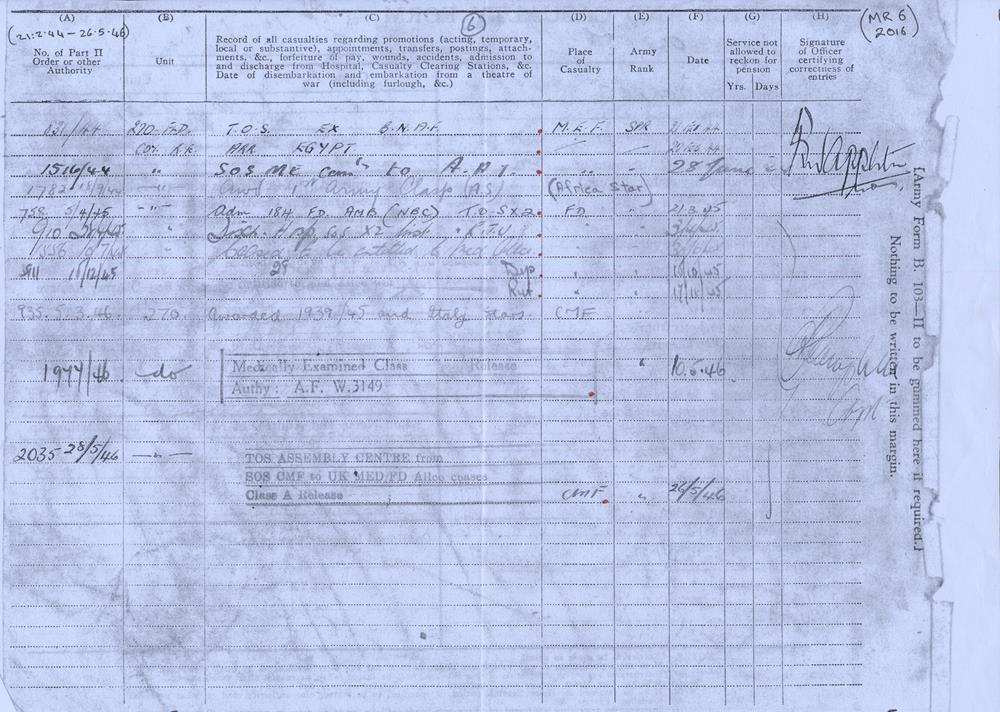John Guthrie – Military Service
| < Introduction | Δ Index | National Service and Conscription > |
The following timeline was compiled from John’s military records. It is vague from the beginning of 1944, however John was awarded the Italy Star so he saw service there. The history of the City of Edinburgh (Fortress) Royal Engineers gives details of the actions they were involved with in North Africa and Italy.
John Guthrie – 1939 to 1943 TIMELINE.
| PLACE | DATE | EVENT |
| Edinburgh | 24th Aug 1939 | Volunteered to join the Territorial Army |
| 28th Aug 1939 | Called out to report to 28 York Place. | |
| 30th Aug 1939 | Received Calling Out Notice. | |
| Cramond Island | 30th Aug 1939 | City of Edinburgh (F) Royal Engineers. |
| 3rd Sep 1939 | WAR DECLARED | |
| 16th Oct 1939 | Luftwaffe Attack Royal Navy Ships in River Forth. | |
| 19th Oct 1939 | Classified Electrician A3. | |
| 8th Apr 1940 | Posted to the 585th (C of E) Corps Field Park Coy RE. | |
| Gosport. England | 23rd Jun 1940 | Attended Course of Instruction at S.E.L |
| Cramond Island | 30th Jun 1940 | Training / Building Defences. |
| 6th Jan 1941 | 7 days Leave. | |
| 8th Jan 1941 | 504th Fife Coastal Reg. RA. | |
| 14th Jan 1941 | Training / Building Defences. | |
| 18th Apr 1941 | 7 Days Leave. | |
| 26th Apr 1941 | Training / Building Defences. | |
| 18th Jul 1941 | 7 Days Leave. | |
| 26th Jul 1941 | Training / Building Defences. | |
| 27th Oct 1941 | 7 Days Leave. | |
| 3rd Nov 1941 | Training / Building Defences. | |
| Halifax England. | 3rd Mar 1942 | Posted to L of C. D.B.R.E. |
| 6th May 1942 | Posted to 3rd T.B.R.E. | |
| Aldershot | 24th Aug 1942 | 7 Days Leave. |
| 3rd Sep 1942 | Posted to C.R.E. No 1 Division. | |
| 5th Sep 1942 | Posted to 238th Field Coy. R.E. | |
| 11th Sep 1942 | Posted to 23rd Field Coy. R.E. | |
| Transit North Africa. | 26th Feb 1943 | |
| North Africa | 9th Mar 1943 | Landed North Africa |
| 12th Mar 1943 | Posted to No 1 G.B. D.R.E | |
| 19th Mar 1943 | Posted to the 270th Field Company Royal Engineers |
John Guthrie – 1944 to 1946 TIMELINE.
| PLACE | DATE | EVENT |
| North Africa | 21st Feb 1944 | Embarked for Egypt SOS BNAF to MEF |
| 21st Feb 1944 | TOS 270 FLD | |
| Egypt | 27th Feb 1944 | Arrived in Egypt |
| 18th Sep 1944 | Awarded Africa Star | |
| 21st Mar 1945 | Adm 184 FD AMB (NBC) TOS X2 [184 Field Ambulance] | |
| 3rd Apr 1945 | Disch Hosp SOS X2 R.T.U [Returned to Unit] | |
| 5th Mar 1946 | Awarded 1939/45 and Italy Stars | |
| Austria | 24th May 1946 | Released from CMF |
Army Acronyms
TOS – “Taken On Strength” of a regiment/unit
SOS – “Struck Off Strength” of a regiment/unit
MEF (Mediterranean Expeditionary Force) – Egypt and desert to Tunis
BNAF – (British North Africa Force) Algiers to Tunis
BNAF – British 8th Army in North Africa Formed in September 1941 from the Western Desert Force, British 8th Army (comprising British, Commonwealth, Free French and Polish troops) went on to wage a lengthy, hard-fought campaign against Axis forces across the deserts of North Africa.
BNAF – Regiment History, War & Military Records & Archives (forces-war-records.co.uk)
CMF (Central Mediterranean Force) Italy and Balkans
John’s Military Records


John’s Service and Casualty Records




City of Edinburgh (Fortress) Royal Engineers – history abridged
from Wikipedia
The City of Edinburgh (Fortress) Royal Engineers was a volunteer unit of the British Army under various titles from 1886 until 1999. Its main role was defence of the Firth of Forth, but it also provided detachments for active service in the field during both World Wars.
Submarine miners
Lieutenant-General Sir Andrew Clarke, Inspector-General of Fortifications 1882–6, decided to utilise Volunteer Engineers to man the fixed mines being installed to defend British ports. The Forth Division Submarine Miners was the fifth unit of Volunteer Submarine Miners, a new corps raised in 1886. Initially, their headquarters was aboard the mine depot ship HMS Dido at Leith. They ended up at Port Laing, North Queensferry in 1900.
Territorial Force
In 1907, the War Office decided to hand all submarine mining duties over to Militia units and the Volunteer submarine miners were disbanded or converted to other roles. Several were converted into Electrical Engineers to make wider use of the coast defence searchlights that had been used to illuminate the minefields. Thus, the Edinburgh-based unit became the Forth Division (Electrical Engineers) (Volunteers).
The following year, under the Haldane Reforms, all the Volunteers were subsumed into the Territorial Force (TF). The Forth Division was retitled as the City of Edinburgh (Fortress) Royal Engineers.
World War II
By the outbreak of war in September 1939, the Edinburgh Fortress Engineers had been reduced to a single company (No 1 Electric Light & Works Company) in the fixed defences under Scottish Command. However, by September 1940, it had been converted into a field engineer unit as Edinburgh Corps Troops Royal Engineers, with 585th, 586th and 587th Army Field Companies.
In July 1942, the unit was reorganised again as 1st Army Troops RE (1st ATRE) to form part of First Army, which was preparing to take part in the Operation Torch landings in North Africa later in the year.
585th Company was converted into an ‘Army Field Park Company’, which acted as a base for the field companies and held specialist equipment.
Tunisian campaign
Operation Torch (8 November 1942 – 16 November 1942) was an Allied invasion of French North Africa. During the operation, a large part of 585th Field Park Company was lost at sea, including its vital equipment. After the landings, the engineering work required was considerable, while the arrival of engineer units was slow and they were widely scattered. In December 1942, a month after the first landing, the Commanding Royal Engineer (CRE) of 1st ATRE, Lt-Col L.E.A. Gwynne, commanded the advanced engineering base at Bône in Tunisia with 587th Field Company and other workshop and park units. Allied ports and bases suffered severely from enemy bombing, and the CRE spent several nights directing the rescue of personnel trapped in bombed buildings at Bône.
Meanwhile, 586th Field Company was working in the Philippeville, Algeria area, including preparing approach roads and cuttings for the 160-foot span Bailey bridge erected at Souk El Khemis. By February, the CRE was in charge of bridging and road improvements to allow transporters carrying the new heavy Churchill tank to reach their concentration area at El Kef.
During the Battle of Kasserine Pass, in February 1943, the right flank of the British V Corps was uncovered, and formations were hastily improvised to fill the gap, including Nickforce and 1st (Guards) Brigade. A composite RE force, including 561st and 587th Field Companies, was sent up, and over three nights laid an extensive minefield under fire from enemy tanks.
To support Eighth Army’s attack on Wadi Akarit on 6 April, First Army attacked towards Kairouan to cut off the enemy retreat. The approach roads for 128th Infantry Brigade Group were little more than 150 miles of sand tracks, and had to be improved by 586th Field Company, assisted by US engineers from II Corps. On 8 April, 128th Bde captured Pichon in an operation requiring two crossings of the bed of the Oued Marguellil and considerable mine clearance. The Tunisian campaign ended on 12 May with the surrender of Armeegruppe Afrika.
Italian campaign
First Army was disbanded at the end of the campaign, and 1st ATRE was transferred to Eighth Army in July 1943 and redesignated 8th Army Troops RE (8th ATRE). Eighth Army began landings in southern Italy on 3 September 1943 and started to advance up the eastern side of the country, using the coastal Highway 16.
At San Salvo the Germans had blown a 340-foot gap in the multi-span brick arch bridge, and destroyed the piers. 561st and 586th Field Companies started work on a replacement the same night that San Salvo was captured, and within 36 hours had built three temporary piers and launched a 340-foot Bailey bridge. Once Taranto had been occupied, 8th ATRE worked with 160th Railway Construction Company RE to rebuild the east coast railways, using Bailey equipment for three important bridges, almost the first time it had been used for a railway.
After the Battle of the Sangro (19 November–3 December), the River Sangro rose rapidly and swept away all the temporary bridges. 8th ATRE began urgent work on 4 December for a high-level Sangro Bridge on Highway 16, the site being floodlit at night. This, which was longest Bailey bridge built during the Italian campaign, was opened to traffic on 14 December.
After the German Winter Line had been breached in the summer of 1944, Eighth Army renewed its advance up Highway 16, with 561st and 586th Field Companies completing a Bailey bridge and a causeway across the River Cessano to prepare the jumping-off line for the assault crossing of the River Metauro on 25 August, after which 586th and 587th Field Companies bridged the Metauro to continue the highway and the causeway while the army moved on to breach the Gothic Line.
In early 1945, 8th ATRE was part of a large engineer force, known as the Po Task Force, which was formed to prepare for the formidable crossing of the River Po. On 9 and 11 April the Senio and Santerno were crossed as the army advanced into the Po Valley, and in the days that followed, 8th ATRE built Bailey bridges across these rivers.
The 360-foot Santerno Bridge was jointly built with the South African Corps Troops Engineers, SAEC, and was thus named the ‘Springlish’ bridge.
On 19 April, 8th ATRE was called in to dam the Marina Canal and prevent flooding. In the final stages of the campaign, the Po and Adige were rapidly crossed, and 8th ATRE remained behind to build a 400-foot high-level Bailey bridge over the Adige to maintain the army’s communications. This was begun on 30 April and opened on 6 May, hostilities in Italy having ended on 2 May.
8th ATRE was disbanded in or after September 1945.
Postwar
When the TA was reconstituted in 1947, 585 (Edinburgh) Field Squadron, RE was formed as an independent unit assigned to 155th (Lowland) Independent Infantry Brigade, but in 1950 it was absorbed into 124 Field Engineer Regiment, RE, the divisional engineers of 52nd (Lowland) Division. A new 586th Independent Field Squadron had been formed by 1956, and in that year a new 585th was formed in 124 Field Engineer Regiment by conversion of part of 413th (Fife) Coast Regiment, Royal Artillery.
In 1961, 585 and 586 Field Squadrons merged with 432 Light Anti-Aircraft Regiment, RA to form 432 (City of Edinburgh) Corps Engineer Regiment, RE. In the reduction of the TA in 1967, 432 Regiment became 104 (City of Edinburgh) Field Sqn in 71 (Scottish) Engineer Regiment. The squadron was disbanded on 1 July 1999.
| < Introduction | Δ Index | National Service and Conscription > |